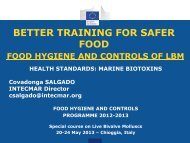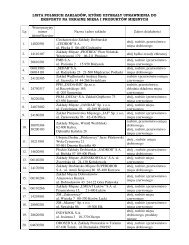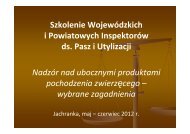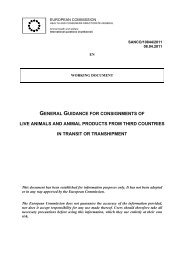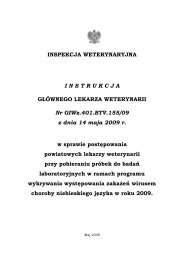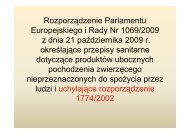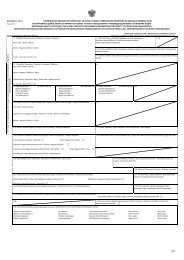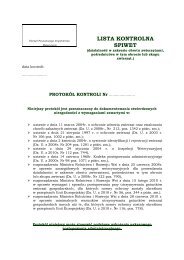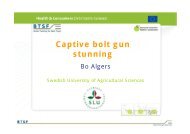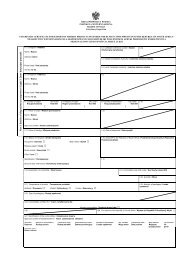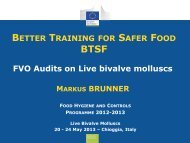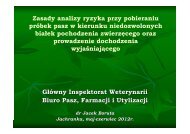Control of food safety in aquaculture products
Control of food safety in aquaculture products
Control of food safety in aquaculture products
Create successful ePaper yourself
Turn your PDF publications into a flip-book with our unique Google optimized e-Paper software.
Adapted from a presentation by David Lyons<br />
BTSF<br />
Workshop on Hygiene and <strong>Control</strong> measures for<br />
Fishery <strong>products</strong> and LBM<br />
<strong>Control</strong> <strong>of</strong> <strong>food</strong> <strong>safety</strong> <strong>in</strong> <strong>aquaculture</strong> <strong>products</strong><br />
Amedeo Manfr<strong>in</strong><br />
Chioggia (Venice) – ITALY<br />
13 September, 2012
BASIC CONCEPTS OF<br />
AQUACULTURE
Basic concepts <strong>of</strong> <strong>aquaculture</strong><br />
• Production cycle<br />
• Production facilities<br />
• Relevant diseases/pathogens<br />
• Treatments
Production cycle<br />
Hatcheries<br />
Spawn<strong>in</strong>g
Production facilities<br />
• Hatcheries<br />
• Nurseries<br />
• Ponds/tanks<br />
• Cages<br />
• Biosecurity<br />
• Water supply<br />
• Feed<strong>in</strong>g systems
Hatcheries
Hatcheries
Nurseries
Ponds/tanks
Cages
Biosecurity
Water supply
Feed<strong>in</strong>g systems
Relevant diseases/pathogens<br />
• Compulsory declaration: most viral diseases<br />
• Public health problems: bacterial diseases<br />
(antibiotics… and some m<strong>in</strong>or zoonoses) and parasitic<br />
diseases (anisakis)
Relevant diseases/pathogens
Treatments<br />
• Antibiotics, dis<strong>in</strong>fectans, antiparasites:<br />
• Limited available <strong>products</strong><br />
• Variable adm<strong>in</strong>istration ways: oral, bath,<br />
<strong>in</strong>jection..<br />
• Withdrawal periods: degree-days<br />
• Alternatives:<br />
• Vacc<strong>in</strong>es (<strong>in</strong>activated)<br />
• Probiotics
Treatments
FRAMEWORK<br />
LEGISLATION
Framework Legislation
Relevant EU legislation for <strong>aquaculture</strong> (1)<br />
• Regulation (EC) 852/2004<br />
Hygiene <strong>of</strong> <strong>food</strong>stuff <strong>products</strong> (Annex I, Primary Production)<br />
• Regulation (EC) 853/2004<br />
Hygiene <strong>of</strong> <strong>food</strong>stuff <strong>of</strong> animal orig<strong>in</strong><br />
• Regulation (EC) 854/2004<br />
Official controls <strong>of</strong> <strong>products</strong> <strong>of</strong> animal orig<strong>in</strong> to be used for human<br />
consumption<br />
• Regulation (EC) 882/2004<br />
On <strong>of</strong>ficial controls performed to ensure the verification <strong>of</strong><br />
compliance with feed and <strong>food</strong> law, animal health and animal<br />
welfare rules
Relevant EU legislation for <strong>aquaculture</strong> (2)<br />
• Regulation (EC) 183/2005<br />
Requirements for feed hygiene<br />
• Regulation (EC) 1831/2003<br />
Additives for use <strong>in</strong> animal nutrition
Relevant EU legislation for <strong>aquaculture</strong> (3)<br />
• Directive (EC) 2006/88<br />
Animal health requirements <strong>of</strong> the <strong>aquaculture</strong> animals and<br />
<strong>products</strong> there<strong>of</strong> and on the prevention and control <strong>of</strong> certa<strong>in</strong><br />
diseases <strong>of</strong> aquatic animals.<br />
• Regulation (EC) 1069/2009<br />
Health rules as regards animal by-<strong>products</strong> and derived<br />
<strong>products</strong> not <strong>in</strong>tended for human consumption.<br />
• Regulation (EC) 142/2011 implement<strong>in</strong>g Regulation (EC) 1069/2009.<br />
(Regulation (EC) 1774/2002 is repealed)
AQUACULTURE AND EU<br />
FOOD SAFETY PACKAGE
Aquaculture and EU <strong>food</strong> <strong>safety</strong> package<br />
• Aquaculture is considered as primary<br />
production, EU <strong>food</strong> <strong>safety</strong> package<br />
• To respect the primary production hygiene<br />
provision (SOP, SSOP standards)
Reg 852 / 2004 Art 6 (<strong>aquaculture</strong>)<br />
Aquaculture Production Bus<strong>in</strong>ess Operator<br />
(APBO):<br />
• approval<br />
• registration<br />
• controls<br />
by Competent Authorities:<br />
• APBO must provide appropriate documentation<br />
<strong>of</strong> the above
Reg 852 / 2004<br />
Annex I Primary production
Primary production (<strong>aquaculture</strong>)<br />
I. Scope<br />
General hygiene provisions for<br />
(<strong>aquaculture</strong>) primary production:<br />
• Aquaculture production<br />
• Associated operations as transport, storage,<br />
handl<strong>in</strong>g, packag<strong>in</strong>g <strong>of</strong> <strong>aquaculture</strong> <strong>products</strong>,<br />
provided that this does not substantially alter<br />
their nature<br />
• Includ<strong>in</strong>g live animals transport from place <strong>of</strong><br />
production to an establishment
Primary production (<strong>aquaculture</strong>)<br />
II. Hygiene provision (1)<br />
• Primary production and associated operations protected<br />
aga<strong>in</strong>st risk <strong>of</strong> contam<strong>in</strong>ation, far from pollution source<br />
• <strong>Control</strong> <strong>of</strong> hazards <strong>in</strong> primary production and associated<br />
operations <strong>in</strong>clud<strong>in</strong>g: air, soil, water, feed, fertiliser,<br />
veter<strong>in</strong>ary medical <strong>products</strong>, plant protection <strong>products</strong><br />
/biocides and waste management …<br />
• Measures relat<strong>in</strong>g to animal health and welfare (also related to<br />
human health).
Primary production (<strong>aquaculture</strong>)<br />
II. Hygiene provision (2)<br />
“…an APBO must take adequate mesures, as appropriate …”<br />
(Good practices, GMP, GHP…)<br />
For activities at <strong>aquaculture</strong> production site (structure and equipment)<br />
•Appropriate project, location, (m<strong>in</strong>imiz<strong>in</strong>g <strong>food</strong> <strong>safety</strong> risk), water quality/quantity<br />
•Structure: <strong>in</strong>put/output channels network, construction <strong>of</strong> pond/tank/ raceway/cage,<br />
fences, waste water treatment system, associated operations (hatchery, feed plant,<br />
packag<strong>in</strong>g area, clean<strong>in</strong>g area, transport), appropriate and easy to clean<br />
•Appropriate storage <strong>of</strong> feed, veter<strong>in</strong>ary <strong>products</strong>, clean<strong>in</strong>g and detergent agents,<br />
fertiliser, dis<strong>in</strong>fectant, tanks (live fish transport conta<strong>in</strong>er), conta<strong>in</strong>er, fuel, lubrificant<br />
•Aquaculture equipment appropriate and easy to clean: conta<strong>in</strong>er, tank, feeder,<br />
oxigenator, selection mach<strong>in</strong>e, pump...
Primary production (<strong>aquaculture</strong>)<br />
II. Hygiene provision (3)<br />
Aquaculture structure and equipment:<br />
• Fences<br />
• Pest traps, pest control plan<br />
• Waste conta<strong>in</strong>ers, <strong>in</strong>c<strong>in</strong>erator<br />
• Quarant<strong>in</strong>e for ill / <strong>in</strong>troduced animals<br />
• Place for personnel wash<strong>in</strong>g and control
Primary production (<strong>aquaculture</strong>)<br />
II. Hygiene provision (4)<br />
Aquaculture operation management<br />
SOP:<br />
• pond preparation<br />
• feed<strong>in</strong>g protocol<br />
• veter<strong>in</strong>ary/fertilizer/chemicals treatment<br />
• toilet/showel/ facilites<br />
• animals conta<strong>in</strong><strong>in</strong>g system<br />
• water quality/quantity monitor<strong>in</strong>g (pond, raceways, cage, tank…)<br />
• health status <strong>of</strong> animal (<strong>in</strong>-present-out)• filter<br />
• fish welfare<br />
• channel network<br />
• analysis: water, feed, animal health,… • decantation ponds<br />
• ma<strong>in</strong>tenance build<strong>in</strong>g/structures /equipment<br />
• pest control<br />
• storage material management<br />
• Transport<br />
• others...<br />
Sanitation SOP:<br />
• clean<strong>in</strong>g surfaces<br />
• surrond<strong>in</strong>g<br />
• personnel hygiene/behavior<br />
• waste management<br />
• others…
Primary production (<strong>aquaculture</strong>)<br />
II. Hygiene provision (5)<br />
Aquaculture operation management<br />
• Traceability <strong>of</strong> animals and materials<br />
• Tra<strong>in</strong><strong>in</strong>g <strong>of</strong> personnel
Primary production (<strong>aquaculture</strong>)<br />
III. Record keep<strong>in</strong>g<br />
• APBO must provide record on hazards control<br />
• Records must be written, divided <strong>in</strong> chapters<br />
as for the developed SOP, SSOP (II. Hygiene<br />
provisions)<br />
• Records must be always available for CA<br />
<strong>in</strong>spection
Associated operations (Good Practices)<br />
• Hatchery (II. Hygiene provisions)<br />
SOP/SSOP for: surface, tank dis<strong>in</strong>fection, water, personnel<br />
health, eggs, f<strong>in</strong>gerl<strong>in</strong>g …<br />
• Packag<strong>in</strong>g (II. Hygiene provisions)<br />
SOP/SSOP for: potable water, ice, fish conta<strong>in</strong>er management,<br />
personnel health, surface cleanless, record keep<strong>in</strong>g…<br />
• Transport (II. Hygiene provisions)<br />
SOP/SSOP for: personnel health, tank easy to use/clean, surface<br />
cleanless, record keep<strong>in</strong>g…<br />
• Primary production <strong>of</strong> feed<br />
Ref Art 5.1 Reg 183/2005 Annex 1 (only owner use)<br />
I. Hygiene provision, SOP, SSOP for: equipment, water, health,<br />
contam<strong>in</strong>ant/residues, feed, personnel health, record keep<strong>in</strong>g…
FEED
Feed<br />
• Regulation (EC) 183/2005<br />
Lay<strong>in</strong>g down requirements for feed<br />
hygiene
Management <strong>of</strong> Feed<br />
<br />
<br />
<br />
Primary production level<br />
Good practice, HACCP<br />
Feed<strong>in</strong>g
Feed bus<strong>in</strong>ess operator responsable for<br />
feed <strong>safety</strong><br />
Objective “To ensure a high level <strong>of</strong> consumer<br />
protection <strong>in</strong> relation to <strong>food</strong> and feed <strong>safety</strong>”<br />
• Regulation (EC) 183/2005 lays down:<br />
• Conditions and arrangements for registration, approval and<br />
control <strong>of</strong> establishments (CA)<br />
• General rules on feed hygiene (Good practices and HACCP)<br />
flexibility<br />
• Conditions and arrangements ensur<strong>in</strong>g traceability <strong>of</strong> feed<br />
along the feed cha<strong>in</strong>
Detail on feed sector<br />
• F<strong>in</strong>ancial Guarantees for FBO (<strong>in</strong>surance, other)<br />
• Flexibility for feed manifactur<strong>in</strong>g <strong>in</strong>clud<strong>in</strong>g associated<br />
operation at primary production level for his exclusive use*<br />
• Feed<strong>in</strong>g practices (SOP)
Feed bus<strong>in</strong>ess at level <strong>of</strong> primary<br />
production Regulation (EC)<br />
183/2005, Art 5(1) & Annex I<br />
• Hygiene provisions (Good practices)<br />
• Record keep<strong>in</strong>g
Feed bus<strong>in</strong>ess at level <strong>of</strong> primary<br />
production<br />
Regulation (EC) 183/2005, Art 5(1) & Annex I<br />
‣ Good Practices: facilities and equipment,<br />
personnel, quality control, storage and<br />
transport, record keep<strong>in</strong>g, compla<strong>in</strong>ts and<br />
product recall…<br />
‣ Hazard analysis and critical control po<strong>in</strong>ts<br />
(HACCP) system pr<strong>in</strong>ciples
RESIDUES AND<br />
CONTAMINANTS
What does residue mean?<br />
Dir. 96/23<br />
• 'residue' shall mean a residue <strong>of</strong> “ substances hav<strong>in</strong>g a<br />
pharmacological action, their metabolites and other<br />
substances transmitted to animal <strong>products</strong> and likely to be<br />
harmful to human health”<br />
Residues are substances that can occur <strong>in</strong> <strong>food</strong>stuffs as a side effect <strong>of</strong> us<strong>in</strong>g<br />
veter<strong>in</strong>ary medic<strong>in</strong>es or phytosanitary <strong>products</strong>. They are unwanted traces <strong>of</strong><br />
medic<strong>in</strong>es or plant protection <strong>products</strong> or derivatives there<strong>of</strong> which rema<strong>in</strong> <strong>in</strong> the<br />
f<strong>in</strong>al product.<br />
• Of veter<strong>in</strong>ay drugs:<br />
– Antibiotics, antiparasites, sedatives, dis<strong>in</strong>fectant…<br />
• Of phytosanitary <strong>products</strong>
Regulation<br />
315/1993<br />
What does contam<strong>in</strong>ant mean?<br />
• “Contam<strong>in</strong>ants are substances that can un<strong>in</strong>tentionally enter <strong>food</strong><br />
dur<strong>in</strong>g its production or market<strong>in</strong>g. These can <strong>in</strong>clude environmental<br />
pollutants, such as diox<strong>in</strong>s and heavy metals”<br />
• E.g: mycotox<strong>in</strong>s, benzopirenes, diox<strong>in</strong>s, hydrocarbures…<br />
• 'Contam<strong>in</strong>ant' means any substance not <strong>in</strong>tentionally added to <strong>food</strong><br />
which is present <strong>in</strong> such <strong>food</strong> as a result <strong>of</strong> the production (<strong>in</strong>clud<strong>in</strong>g<br />
operations carried out <strong>in</strong> crop husbandry, animal husbandry and<br />
veter<strong>in</strong>ary medic<strong>in</strong>e), manufacture, process<strong>in</strong>g, preparation,<br />
treatment, pack<strong>in</strong>g, packag<strong>in</strong>g, transport or handl<strong>in</strong>g <strong>of</strong> such <strong>food</strong>, or<br />
as a result <strong>of</strong> environmental contam<strong>in</strong>ation.
Example: cycle <strong>of</strong> contam<strong>in</strong>ant
Residue analysis importance<br />
• Sanitary importance<br />
– Participation <strong>of</strong> all <strong>in</strong>volved parts <strong>of</strong> the whole <strong>food</strong> cha<strong>in</strong><br />
• Aquaculture farmers, veter<strong>in</strong>arians, legislators,<br />
laboratories, judges, consumers…<br />
• Comercial importance: residues control affects trade<br />
<strong>products</strong> <strong>of</strong> animal orig<strong>in</strong>.<br />
– Differences between countries depend<strong>in</strong>g on drugs<br />
viability, analytic methods…
EU legislation<br />
• Directive 96/23/EC<br />
On measures to monitor certa<strong>in</strong> substances and residues there<strong>of</strong> <strong>in</strong> live<br />
animals and animal <strong>products</strong><br />
• Decision 2002/657/EC<br />
Implement<strong>in</strong>g Council Directive 96/23/EC concern<strong>in</strong>g the performance <strong>of</strong><br />
analytical methods and the <strong>in</strong>terpretation <strong>of</strong> results<br />
• Regulation (EC) 470/2009<br />
Lay<strong>in</strong>g down a Community procedure for the establishment <strong>of</strong> maximum<br />
residue limits <strong>of</strong> veter<strong>in</strong>ary medic<strong>in</strong>al <strong>products</strong> <strong>in</strong> <strong>food</strong>stuffs <strong>of</strong> animal<br />
orig<strong>in</strong>, repeal<strong>in</strong>g Reg. 2377/1990 and …<br />
• Regulation 37/2010<br />
On pharmacologically active substances and their classification<br />
regard<strong>in</strong>g maximum residue limits <strong>in</strong> <strong>food</strong>stuffs <strong>of</strong> animal orig<strong>in</strong>
EU legislation<br />
• Directive 96/23 legal framework control <strong>of</strong> residues <strong>in</strong> <strong>products</strong> <strong>of</strong><br />
animal orig<strong>in</strong><br />
• Requires Member States to develope a detection plan <strong>of</strong> residues<br />
depend<strong>in</strong>g on animal species and risks<br />
• Sample system depend<strong>in</strong>g on:<br />
Previous results<br />
Region situation<br />
Evidence <strong>of</strong> abuse <strong>of</strong> substances …<br />
• Groups to be checked:<br />
• Veter<strong>in</strong>ary drugs (MLRs, Annex I, Table 1 Reg. 37/2010)<br />
• Forbidden drugs (Annex I, Table 2 Reg. 37/2010)<br />
• β-agonists and forbidden drugs (zero tolerance)<br />
• Enviromental contam<strong>in</strong>ants (diox<strong>in</strong>s, heavy metals,<br />
colorants…)
EU legislation: Directive 96/23<br />
• Group A: Substances hav<strong>in</strong>g anabolic effect and unauthorised substances<br />
• Group B: Veter<strong>in</strong>ary drugs and contam<strong>in</strong>ants<br />
(1)Antibacterial substances, <strong>in</strong>clud<strong>in</strong>g sulphonomides, qu<strong>in</strong>olones<br />
(2)Other veter<strong>in</strong>ary drugs<br />
(a) Anthelm<strong>in</strong>tics<br />
(b) Anticoccidials, <strong>in</strong>clud<strong>in</strong>g nitroimidazoles<br />
(c) Carbamates and pyrethroids<br />
(d) Sedatives<br />
(e) Non-steroidal anti-<strong>in</strong>flammatory drugs (NSAIDs)<br />
(f) Other pharmacologically active substances<br />
(3) Other substances and environmental contam<strong>in</strong>ants<br />
(a) Organochlor<strong>in</strong>e compounds <strong>in</strong>clud<strong>in</strong>g PCBs<br />
(b) Organophosphorus compounds<br />
(d) Chemical elements<br />
(d) Mycotox<strong>in</strong>s<br />
(e) Dyes<br />
(f) Others
Veter<strong>in</strong>ary drugs residues<br />
• For the us<strong>in</strong>g <strong>of</strong> a veter<strong>in</strong>ary drug <strong>in</strong> animals dest<strong>in</strong>ated to<br />
human consumption, its active pr<strong>in</strong>ciple must be <strong>in</strong>:<br />
Annex I, Table 1, REGULATION (EC) 37/2010 on<br />
pharmacologically active substances and their<br />
classification regard<strong>in</strong>g maximum residue limits <strong>in</strong><br />
<strong>food</strong>stuffs <strong>of</strong> animal orig<strong>in</strong><br />
The use <strong>of</strong> any substances <strong>in</strong>cluded <strong>in</strong> Annex I,Table 2, is<br />
forbidden <strong>in</strong> EU (chloranphenicol, nitr<strong>of</strong>uranes and their<br />
metabollites)
Regulation (EEC) 37/2010<br />
on pharmacologically active substances and their classification<br />
regard<strong>in</strong>g maximum residue limits <strong>in</strong> <strong>food</strong>stuffs <strong>of</strong> animal orig<strong>in</strong><br />
• Annex I, Table 1: Allowed substances – with and<br />
without MRLs<br />
Antibiotics (streptomyc<strong>in</strong>), antiparasites(albendazol),<br />
anti-<strong>in</strong>flammatories (carpr<strong>of</strong>en)…<br />
• Annex I, Table 2: Prohibited substances<br />
Aristolochia spp, chloramfenicol, chlor<strong>of</strong>orm,<br />
clorpromaz<strong>in</strong>e, colchic<strong>in</strong>e, dapsone, dimetridazole,<br />
metronidazole, nitr<strong>of</strong>urazone, ronidazole.
MRL<br />
• Determ<strong>in</strong>ation establish residues and contam<strong>in</strong>ats <strong>of</strong>ficial<br />
limits that don't mean a risk for human health. Depend on<br />
substance toxicity.<br />
• EMA (European Medic<strong>in</strong>es Agency) (formerly EMEA):<br />
scientific organ which establish veter<strong>in</strong>ay drugs MRL<br />
http://www.ema.europa.eu/
MRL<br />
• No MRL for an active substance for every specie:<br />
Cost/benefit problems. Limit use <strong>of</strong> drugs<br />
“M<strong>in</strong>or spp” (horses, rabbits, bees, fishes…) or rare<br />
diseases<br />
“Cascade procedure”
AQUACULTURE VETERINARY DRUGS<br />
RESIDUES AND CONTAMINANTS
Aquaculture & veter<strong>in</strong>ary drugs<br />
• Codex Guidel<strong>in</strong>es:<br />
“ Any veter<strong>in</strong>ay drug for <strong>aquaculture</strong> must comply with national regulations<br />
and <strong>in</strong>ternational guidel<strong>in</strong>es” (<strong>in</strong> accordance with the International Code<br />
Recomended <strong>of</strong> practices <strong>of</strong> control the Use <strong>of</strong> Veter<strong>in</strong>ary Drugs CAC/RCP<br />
38-1993).<br />
The regulation <strong>of</strong> the use <strong>of</strong> these substances must go on <strong>in</strong> accordance<br />
with Codex Guidel<strong>in</strong>es for the Establishment <strong>of</strong> Regulation Programme for<br />
the <strong>Control</strong> <strong>of</strong> veter<strong>in</strong>ary drugs residues on <strong>food</strong> (CAC/GL 16-1993)<br />
• Veter<strong>in</strong>ary drugs <strong>in</strong> <strong>aquaculture</strong>:<br />
“whatever active substance applicated or adm<strong>in</strong>istrated to any animal, <strong>in</strong><br />
particular those dest<strong>in</strong>ated to <strong>food</strong> production like fishes and crustaceans,<br />
for therapeutic purpose or disease diagnosis”
Good Practices <strong>in</strong> the use <strong>of</strong> Veter<strong>in</strong>ay<br />
Drugs (GPVD) <strong>in</strong> <strong>aquaculture</strong><br />
• Vigilance <strong>in</strong> the compliance <strong>of</strong> withdrawal periods <strong>in</strong> fish batches<br />
• Use drugs and medicated feeds under manufacturer <strong>in</strong>structions<br />
• National Register on prescribed and dispensed medic<strong>in</strong>es<br />
• Prescription accord<strong>in</strong>g national legislation<br />
• <strong>Control</strong> <strong>of</strong> conditions <strong>of</strong> storage and transport<br />
• Drugs records<br />
• If the concentration is higher than the MRL, the harvest should be put <strong>of</strong>f<br />
• All fishery <strong>products</strong> that don't comply with national requirements about<br />
drugs residues should be disposed
Responsible use
Use <strong>of</strong> drugs <strong>in</strong> <strong>aquaculture</strong><br />
Example - Regulation (EEC) 37/2010 application<br />
• Veter<strong>in</strong>ary drugs <strong>in</strong> salmonids and other fishes:<br />
Annex I, Table 1, Free use: formaldehyde, hydrogen peroxide,<br />
chlorure sodium, magnesium sulphate…<br />
Annex I, Table 1, with MRL: amoxicil<strong>in</strong>, flumequ<strong>in</strong>e, sarafloxac<strong>in</strong>e<br />
(salmonids), trimetroprim…<br />
Annex I, Table 2, Prohibited: chloramfenicol, chlor<strong>of</strong>orm…<br />
• M<strong>in</strong>or spp: cascade procedure<br />
Give an animal or group <strong>of</strong> animals an authorized veter<strong>in</strong>ary drug for<br />
another spp or diferent disease; or human drug, or magistral<br />
prescription, preparation or <strong>of</strong>ic<strong>in</strong>al prescription for veter<strong>in</strong>ay use.<br />
Veter<strong>in</strong>ary will establish a withdrawal period not lower than 500<br />
degree-day for flesh.
Management <strong>of</strong> Veter<strong>in</strong>ary Drugs<br />
and other Chemicals<br />
Veter<strong>in</strong>ary Drugs, medicated feeds, chemical and<br />
biological substance are:<br />
• duly recorded<br />
• supervised by qualified expert<br />
• by adequate language, labeled with clear <strong>in</strong>formation.<br />
• adequately stored<br />
• verified by adequate test<strong>in</strong>g for withdrawal periods and<br />
residues
Food <strong>safety</strong> hazards related to<br />
<strong>aquaculture</strong> residues<br />
• Antibiotic residues:<br />
Used to fight aga<strong>in</strong>st diseases<br />
High use before 1990<br />
Vacc<strong>in</strong>es aga<strong>in</strong>st pr<strong>in</strong>cipal diseases decrease the use<br />
Antimicrobial resistances<br />
“Integrated Agriculture Systems” (pigs+poultry+<strong>aquaculture</strong>):<br />
leav<strong>in</strong>gs <strong>of</strong> <strong>food</strong> can be feed for fishes<br />
Commission: more antibiotical analysis <strong>in</strong> <strong>aquaculture</strong>
Food <strong>safety</strong> hazards related to<br />
<strong>aquaculture</strong> residues<br />
• Malachite green :<br />
Toxic chemical primarily used as a dye<br />
To treat fungal <strong>in</strong>fections. Great effectivity <strong>in</strong> fish<br />
Unathorized as veter<strong>in</strong>ary drug.<br />
Carc<strong>in</strong>ogenic<br />
Banned <strong>in</strong> EU s<strong>in</strong>ce 2001<br />
Detection <strong>in</strong> fish and <strong>products</strong> malachite and the<br />
metabollite leucomalachite green<br />
There is also “crystal violet” <strong>in</strong> eels<br />
MRPL = 2 ppb<br />
F<strong>in</strong>d<strong>in</strong>gs <strong>in</strong> salmon and catfish (bagre)<br />
Also <strong>in</strong> fish com<strong>in</strong>g from Ch<strong>in</strong>a
Food <strong>safety</strong> hazards related to<br />
<strong>aquaculture</strong> residues<br />
• Environmental contam<strong>in</strong>ants:<br />
– Heavy metals:<br />
• E.g. methyl-mercury (not accumulate <strong>in</strong> fat tissues,<br />
concentrate along years)<br />
• Accumulation <strong>in</strong> <strong>food</strong> cha<strong>in</strong><br />
• Uncontrollable except decreas<strong>in</strong>g atmospheric pollution<br />
– PCBs and diox<strong>in</strong>s: persistent organic contam<strong>in</strong>ants<br />
(<strong>in</strong>dustrials)<br />
• Accumulation <strong>in</strong> fat<br />
• Tuna, mackerel, salmon, herr<strong>in</strong>g…
RESIDUES MONITORING<br />
PROGRAMME
Residues Monitor<strong>in</strong>g Programme<br />
• Establish control measures <strong>of</strong> substances and<br />
residues which can be adm<strong>in</strong>istrated to animals and<br />
by this way can be detected <strong>in</strong> whatever phase <strong>of</strong><br />
<strong>food</strong> cha<strong>in</strong>, <strong>in</strong> alive animals and their <strong>products</strong> (CA)<br />
• Establish bus<strong>in</strong>ess operators responsibility <strong>in</strong><br />
relation to farmer sector.
Residues Monitor<strong>in</strong>g Programme EU<br />
• Directive 96/23 establishes measures to<br />
monitor certa<strong>in</strong> substances and residues<br />
there<strong>of</strong> <strong>in</strong> live animals and animal <strong>products</strong><br />
• A central organization must:<br />
• Design national plan<br />
• Coord<strong>in</strong>ate central and regional activities<br />
• Recover necessary data<br />
• Send plans y results to EC
Residues Monitor<strong>in</strong>g Programme<br />
Directive 96/23/EC<br />
• Residues <strong>of</strong> unauthorised or banned substances e.g.<br />
hormones, steroids … Directive 96/22/EC<br />
• Residues <strong>of</strong> permitted veter<strong>in</strong>ary drugs <strong>in</strong> excess <strong>of</strong><br />
the maximum permitted limits (MRL) e.g. antibiotics,<br />
anticoccidiostats … Regulation 37/2010/EC<br />
• Environmental contam<strong>in</strong>ants e.g. heavy metals,<br />
diox<strong>in</strong>s, etc. Regulation 1881/2006/EC<br />
Pesticides Regulation 396/2005/EC
EU FINDINGS 2007-<br />
2010
Pr<strong>in</strong>cipal f<strong>in</strong>d<strong>in</strong>gs EU 2010<br />
• Similar number and distribution <strong>of</strong> NC than previous years<br />
• Slight decrease <strong>of</strong> NC for steroids, resorcylic acid lactones,<br />
anticoccidials, organochlor<strong>in</strong>e compounds and mycotox<strong>in</strong>s<br />
• Increment <strong>of</strong> NC for chemical elements (ma<strong>in</strong>ly heavy metals)<br />
• Green malachite problem cont<strong>in</strong>ues, its prevalence<br />
cont<strong>in</strong>ues decreas<strong>in</strong>g slowly. In many cases the research<br />
has not identified illegal use and its presence can only be<br />
understood by the long persistence <strong>of</strong> green leuco malachite<br />
<strong>in</strong> water and ground (depend<strong>in</strong>g on the concentrations and<br />
later researches)
Aquaculture Results 2008<br />
2010 2009 2008 2007<br />
UE production<br />
(tons)<br />
622 032 627 109 644 875 602 555<br />
Samples directed 8 668 8 606 8 751 9 257<br />
NC directed 41 61 75 69<br />
Samples<br />
suspected<br />
171 335 235 344<br />
NC suspected 26 57 116 122
Non-compliant Aquaculture<br />
Results<br />
2010 2009 2008 2007<br />
A3. Steroids - 2 9 2<br />
A6. Prohibited<br />
substances<br />
1<br />
AMOZ<br />
- 1<br />
Chloranfenicol<br />
3<br />
Chloranfenicol<br />
B1. Antibacterials 1 9 8 10<br />
B2a. Antihelm<strong>in</strong>tics - 3 2 -<br />
B3a. Diox<strong>in</strong>s 2 3 4 4<br />
B3c. Heavy metals - 4 10 3<br />
B3e. Malaquite<br />
green<br />
37 / 26 40 / 57 41 / 112 47 / 117
2010
2010
Laboratory network <strong>in</strong> the EU<br />
Anabolics<br />
Sedatives<br />
Beta-agonists<br />
NSAIDs<br />
Coccidiostats<br />
Antibiotics<br />
Malachite green<br />
Heavy metals
HEALTH STATUS
Health National Competent Authority tasks<br />
Directive 2006 / 88<br />
• Authorisation Art.4 granted by CA to Aquaculture<br />
Production Bus<strong>in</strong>ess Operator based on: traceability, GHP,<br />
def<strong>in</strong>ition <strong>of</strong> epidiemological unit, surveillance scheme,<br />
cont<strong>in</strong>gency plan.<br />
• CA cover the follow<strong>in</strong>g: APBO art 10, FBO art 4,<br />
Ornamental APBO art 21 , transport art 8, wild population<br />
Art 15-36-4 , game fish lake art 15.<br />
• Regular CA <strong>of</strong>ficial controls health <strong>in</strong>spection:<br />
Cl<strong>in</strong>ical diagnosis<br />
Samples<br />
Register health status<br />
Releas<strong>in</strong>g certificate
Aquaculture Production Bus<strong>in</strong>ess Operators tasks<br />
Directive 2006 / 88, Art 8, 9 &10<br />
APBO tasks:<br />
• Traceability: mortality, animal<br />
movements, transport water exchange.<br />
• Good Hygiene Practices<br />
• Risk based health surveillance scheme
Stamp<strong>in</strong>g out <strong>of</strong> <strong>in</strong>fected farm,<br />
dis<strong>in</strong>fection for trucks
Official control and animal health surveillance<br />
Directive 2006 / 88, Art 7 &10 CA<br />
• Animal health surveillance scheme (CA)<br />
based on: risk analysis, register at national level,<br />
control programme and vacc<strong>in</strong>ation, <strong>in</strong>troduction<br />
from EU producers<br />
• Third countries same system than EU with audit<br />
by EU for local CA (Art 58)<br />
• Animal health certification: plac<strong>in</strong>g on the<br />
market, process<strong>in</strong>g, partial process<strong>in</strong>g, restok<strong>in</strong>g,<br />
parents, gametes, quarant<strong>in</strong>e, …
Health status <strong>of</strong> <strong>aquaculture</strong> zones or compartments<br />
Directive 2006 / 88, Annex III Part A<br />
Health<br />
category<br />
Health status<br />
Intro<br />
from<br />
Dispatch<br />
to<br />
I Disease free (Art 49, 50) I I – V<br />
II<br />
Surveillance programme (Art<br />
44) 1<br />
I<br />
III + V<br />
III<br />
Undeterm<strong>in</strong>ed: ”Not known to<br />
be <strong>in</strong>fected but not subject to<br />
eradication programme for<br />
achiev<strong>in</strong>g disease free status<br />
I-II-III<br />
III + V<br />
IV<br />
Eradication programme (Art<br />
44) 2<br />
V Infected (Art 39) I - V V<br />
I<br />
V
Keep<strong>in</strong>g Records<br />
<br />
<br />
<br />
<br />
<br />
<br />
<br />
<br />
Pond management<br />
Notification and m<strong>in</strong>imum measures for control <strong>of</strong> diseases<br />
Slaughter and process<strong>in</strong>g<br />
Type, orig<strong>in</strong> and use <strong>of</strong> feed and feed <strong>in</strong>gredients<br />
Veter<strong>in</strong>ary drugs or other treatments adm<strong>in</strong>istered<br />
Eggs, fry and f<strong>in</strong>gerl<strong>in</strong>g traceability<br />
Buyers <strong>of</strong> f<strong>in</strong>al <strong>products</strong><br />
… any activities connected with health status
ANIMAL BY-PRODUCTS NOT<br />
INTENDED FOR HUMAN<br />
CONSUMPTION
Animal by-<strong>products</strong> (ABP) not <strong>in</strong>tended for<br />
human consumption<br />
• Regulation (EC) 1069/2009<br />
Health rules as regards animal by-<strong>products</strong><br />
and derived <strong>products</strong> not <strong>in</strong>tended for human<br />
consumption.<br />
• Regulation (EC) 142/2011<br />
Implement<strong>in</strong>g Regulation (EC) 1069/2009
Aim<br />
• ABPs can spread animal diseases or chemical<br />
contam<strong>in</strong>ants, and can be dangerous to animal<br />
and human health if not properly disposed <strong>of</strong>.<br />
• EU rules regulate their movement, process<strong>in</strong>g and<br />
disposal.<br />
• ABPs are categorised accord<strong>in</strong>g to their risk us<strong>in</strong>g<br />
the basic pr<strong>in</strong>ciples <strong>in</strong> Regulation EC 1069/2009
Basic pr<strong>in</strong>ciples<br />
• ABP not <strong>in</strong>tended for human consumption<br />
don’t come back to the <strong>food</strong> cha<strong>in</strong> (directly<br />
or <strong>in</strong>directly)<br />
• Recycl<strong>in</strong>g <strong>in</strong>traespecie is forbidden. Animals<br />
can’t be feeded on prote<strong>in</strong> <strong>of</strong> their own<br />
specie<br />
• Management, use, elim<strong>in</strong>ation without<br />
spread harmful agents for public health,<br />
animal health and environment
Measures to apply<br />
Depend on ABPs category is necessary to handl<strong>in</strong>g:<br />
• Production<br />
• Collection<br />
• Transport<br />
• Storage<br />
• Use<br />
• Disposal<br />
EU national authorities make <strong>of</strong>ficial controls on<br />
ABP imports from non-EU countries.
What is new<br />
• Clear requirements based on ABPs' technical standards<br />
• Enforcement measures for new risk-proportionate approach<br />
• End po<strong>in</strong>t <strong>in</strong> manufactur<strong>in</strong>g cha<strong>in</strong> for processed and<br />
packaged pet <strong>food</strong>, biodiesel, tanned hides and sk<strong>in</strong>s and<br />
other <strong>products</strong><br />
• Better traceability from <strong>food</strong> production;<br />
• Risk-proportionate solutions for transport, process<strong>in</strong>g, use<br />
and imports
Regulation objective:<br />
Preserve…<br />
• Public Health<br />
• Animal Health<br />
• Environment
To achieve:<br />
• Correct treatment <strong>of</strong> Animal by-<strong>products</strong><br />
not <strong>in</strong>tended for human consumption<br />
• Suitable handl<strong>in</strong>g <strong>of</strong> process<strong>in</strong>g<br />
<strong>products</strong>.<br />
• Identification, registration, approval and<br />
control <strong>of</strong> agents.<br />
• Traceability: documentation, record<strong>in</strong>g,<br />
labell<strong>in</strong>g.
Classification<br />
Bases for<br />
classification<br />
Examples<br />
Possible uses<br />
BSE risk<br />
CATEGORY 1<br />
Unknown hazards or<br />
related to illegal<br />
substances or<br />
environmental<br />
pollutants.<br />
Material Specified <strong>of</strong> Risk<br />
<strong>in</strong> rum<strong>in</strong>ants<br />
Specific treatment and<br />
controlled destruction<br />
CATEGORY 2<br />
Other hazards related to<br />
animal diseases or<br />
residues <strong>of</strong> veter<strong>in</strong>ary<br />
medic<strong>in</strong>al <strong>products</strong><br />
Dead animals <strong>in</strong> farms<br />
Specific treatment and<br />
controlled destruction<br />
or possible uses (e.g.<br />
manure, production <strong>of</strong><br />
bio-gas, ...).<br />
CATEGORY 3<br />
Healthy animals with<br />
ante and post-mortem<br />
<strong>in</strong>spection<br />
Proces<strong>in</strong>g plants vessels<br />
<strong>products</strong> suitable for<br />
human consumption, but<br />
they aren’t dest<strong>in</strong>ed to<br />
such purpose for different<br />
reasons<br />
Specific treatment and<br />
possible uses (e.g. animal<br />
feed for pets, leather<br />
tann<strong>in</strong>g, ...).
Dangers derived from their use<br />
• Biologicals: pathogens<br />
(zoonoses, BSE…)<br />
For Public Health<br />
For Animal Health<br />
For Enviroment<br />
• Residues <strong>of</strong> drugs<br />
(resistances,<br />
<strong>in</strong>tolerances, allergies)<br />
• Contam<strong>in</strong>ants (diox<strong>in</strong>s)<br />
• Water contam<strong>in</strong>ation<br />
(high content <strong>of</strong> organic<br />
matter)<br />
• …
Dangers derived from their<br />
elim<strong>in</strong>ation<br />
For Public Health<br />
For Animal Health<br />
For Enviroment<br />
• Inc<strong>in</strong>eration, pollution,<br />
greenhouse effect<br />
• Dumps: water<br />
contam<strong>in</strong>ation, high<br />
oxygen biological<br />
demand<br />
• …
Objectives<br />
‣ Food Safety:<br />
Coherence with the White Book <strong>of</strong> Food Safety and BSE legislation.<br />
Traceability.<br />
“Mad cows, nevermore”<br />
‣ Animal Health:<br />
Threat <strong>of</strong> highly contagious and exotic/emergent diseases<br />
“Prevent, better than treat”<br />
‣ Environment:<br />
Connect with residues legislation, pr<strong>in</strong>ciple <strong>of</strong> respectfully to the<br />
environment<br />
“Who contam<strong>in</strong>ates, pays”
THANK YOU for YOUR ATTENTION<br />
manfr<strong>in</strong>@izsvenezie.it



